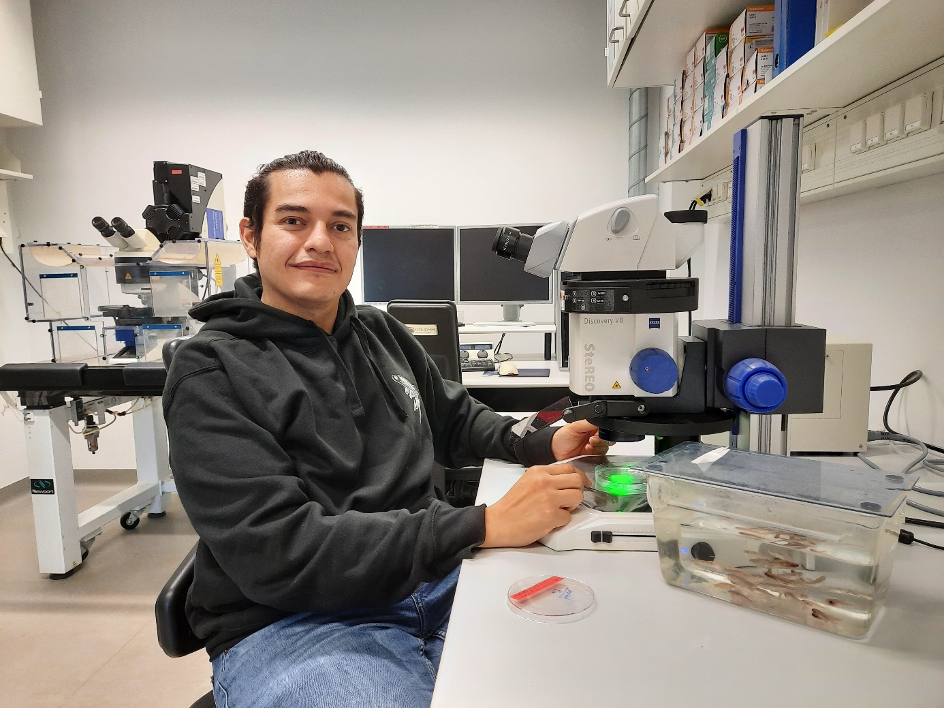
Single-cell optogenetics reveals leader cells at the top of the functional hierarchy of pancreatic β-cells in vivo
On April 16th, we held the first Virtual Pub Special Edition, making room for Flash presentations from academia and industry, on the topic of “Speed in Imaging.” During this event, Luis Fernando Delgadillo Silva, of the Centre for Regenerative Therapies TU Dresden at the Technische Universität Dresden, presented his work on the function of pancreatic β-cells in vivo. His presentation was voted “Best Academic Talk” by the audience. In the interview below, Luis shares some highlights from his work – and answers some of our questions about speed and imaging.

Tell us about your work:
The coordination of activity is present in all the nature, from the harmonized flight of starlings during the marvel of murmuration to avoid predators to the coordinated activity of large areas of our brain to generate ideas.
The precise coordination of the pancreatic islets is also critical for the proper control of our blood glucose levels. When we are healthy, our β-cells efficiently keep the right glucose levels by secreting the exact amount of required insulin. The hormone of insulin controls the glucose levels in our body. Unfortunately, when our β-cells are not working properly, we can develop pathological conditions such as Type 2 diabetes (T2D). New studies show that in T2D patients the number of β-cells is similar to the number in healthy people, however, the insulin secretion is not enough. Our work aims to understand how pancreatic β-cells coordinate their activity to sustain glucose homeostasis. We found that there is a particular type of β-cell which helps to start and coordinate the rest of the β-cells. We call this newly discovered cell the “leader” β-cells.
We employed fast calcium imaging with 6 images taken per second and optogenetic manipulation in vivo, to show that this subpopulation of β-cells orchestrates the islet’s calcium activity in living zebrafish larvae. This is what I presented at the Virtual Pub Special Edition.
Why is being fast important in this context?
We started this work by exploring the endogenous calcium activity of the β-cells in living zebrafish larvae. We employed a transgenic line of zebrafish, which express the Genetically Encoded Calcium Indicator (GECI) GCaMP6s. Since the process of insulin secretion requires the influx of calcium into the β-cells, we can use the calcium signal we get from GCaMP as a proxy for β-cell function. We started by imaging the complete islet every 10 seconds, and we found that the β-cells present endogenous activity, with seemingly uncoordinated calcium transients. However, after we stimulated the β-cells with some glucose, all the β-cells showed a fast and coordinated glucose-induced influx of calcium. As we started to increase the speed of imaging up to 6Hz or ~150 ms per frame, we were able to resolve the time of response of individual β-cells. We realized that the glucose response starts at a discrete cell and if we trigger the glucose response several times, it starts in the same cell rather that at different positions. As we needed to resolve the time of response for each cell being as fast as the β-cells was essential.
What microscopy implementation do you use for the fast calcium imaging and why is that the most suitable technology for your work?
We routinely use confocal microscopy coupled with a resonant scanner for fast in vivo calcium imaging. The resonant scanner can take an X and Y image of 512px in around 40ms. Using this technology, we are able to capture the whole islet with an acquisition rate of 0.8Hz and covering ~700μm3. This allows us to resolve the time of response for the majority of the β-cells in the zebrafish primary islet in vivo.
Tell us about your future projects…
Our next frontier is to better understand why the leader cell has the capability to initiate and lead the response of other β-cells. We are also trying to define a molecular signature for the leader cell. Finally, we are exploring if connexins allows the leader cell to spread calcium and activate the rest of the β-cells.
Confocal imaging of the primary islet from a larva mounted in agarose upon glucose bolus. The zebrafish pancreatic β-cells express the genetically encoded calcium indicator GCaMP6s (green) and cdt1-mCherry (red-nuclei) under the insulin promoter. The leader-cell is among the cells that responds first to the glucose bolus and coordinate the rest of the β-cells.
About Euro-BioImaging
Euro-BioImaging is the European landmark research infrastructure for biological and biomedical imaging as recognised by the European Strategy Forum on Research Infrastructures (ESFRI). Euro-BioImaging provides open access to imaging instruments, expertise, training opportunities and data management services that life scientists might not find at their home institutions or among their collaboration partners. All scientists, regardless of their affiliation, area of expertise or field of activity can benefit from these pan-European services, which are provided with high quality standards by leading imaging facilities.
More news from Euro-BioImaging


